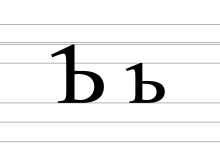Ƅ (minuscule: ƅ) is a letter of the Latin alphabet used in the Zhuang alphabet and Bouyei alphabet from 1957 to 1986[1] to indicate the sixth tone, mid-level [˧]. The 'b' shape was chosen for the letter because it resembles the digit '6', and the character represents the sixth tone. In 1986, it was replaced by h.
| Ƅ | |
|---|---|
| Ƅ ƅ | |
 | |
| Usage | |
| Writing system | Latin script |
| Type | alphabetic |
| Language of origin | Bouyei language, Zhuang language |
| Sound values | [˧] |
| In Unicode | U+0184, U+0185 |
| History | |
| Development | |
| Time period | 1957-1986 |
Computing codes
edit| Preview | Ƅ | ƅ | ||
|---|---|---|---|---|
| Unicode name | LATIN CAPITAL LETTER TONE SIX | LATIN SMALL LETTER TONE SIX | ||
| Encodings | decimal | hex | dec | hex |
| Unicode | 388 | U+0184 | 389 | U+0185 |
| UTF-8 | 198 132 | C6 84 | 198 133 | C6 85 |
| Numeric character reference | Ƅ |
Ƅ |
ƅ |
ƅ |
See also
editReferences
edit- ^ Zhou, Minglang (2003). Multilingualism in China: The Politics of Writing Reforms for Minority Languages 1949–2002. Berlin: Mouton de Gruyter. pp. 251–258. ISBN 3-11-017896-6.